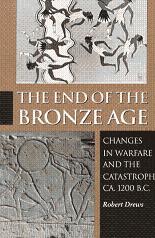
The End of the Bronze Age
Robert Drews
252 pages including index
published in 1993
Sometimes pickings are slim at the library and you just have to take what you can get rather than what you want. This is especially true for the history section, which is why I took out this book, as it looked the best of a sorry bunch. Luckily it turned out a blessing in disguise. The Bronze Age is not a period I know little more than a very few basic facts about, so any reasonably well written book about it is welcome. Even if, like this, it's a decade and a half old and therefore likely to be out of date.
There is a catch however. The End of the Bronze Age is not a pop science book but a proper acadmic study, arguing a thesis and it assumes a certain background familiarity of its readers. I can usually fake this reasonably well, but of course I can't really judge whether or not the conclusions its author Robert Drews reaches are justified by the evidence, only whether they sound plausible. And when you're ignorant of a given subject, even abject nonsense can sound plausible -- which has tripped me up before...These days I use Wikipedia as a sanity check: it's not perfect, but on most subjects it's a good indicator of mainstream opinion.
The End of the Bronze Age: changes in Warfare and the Catastrophe ca. 1200 B.C. attempts to explain the almost simultaneous destruction and collapse of the great Bronze Age civilisations in the Eastern Mediterranean and the Near East. In a period of less than a century the great civlisation centres of Mycean Greece and Crete, the Hittite Empire and of Palestine --not to mention Troy--, were all destroyed, with many abandoned forever and others rebuilt on a much smaller scale. Civilisation collapsed and even those empires that came through this Catastrophe relatively unscathed, like Egypt and Assyria were much weakened. The region as a whole entered a dark age, only emerging out of it around 800 b.c. when what think of as the classical ancient civilisations emerged: Greece, Rome and so on.
Over the years there have been quite a few attempts at explaining how this Catastrophe happened, once it had become clear it had happened and wasn'r just myth. These explanations have followed the fashions of their time and range from a series of devastating earthquakes, invasions by migrating barbarians to system collapse due to the inherent instability of Bronze Age societies, the development of iron working replacing bronze based civilisations and drought. Unsurpringly Drews disagrees with all these explanations, in favour of his own and The End of the Bronze Age is an attempt to argue for it.
Drews divides this attempt in three parts. The first part starts with a general overview of the Catastrophe, followed by a survey of the various Late Bronze Age population centres and how the Catastrophe impacted them. The second part is an overview of all the proposed causes of the Catastrophe and the arguments against them. Finally, in the third part, Drews put forward his own solution, presents the evidence for it and argues why it is a better fit than the ones he discarded.
To fit the facts, any explanation has to be timed just right, have enough width to explain the near-simultaneus destruction of widely spreadout cities, not contradict archeological evidence and preferably be supported by it and of course make sense. It must also be able to explain why the Catastrophe happened at the time it did, rather than later of earlier. It's on these criteria that Drews dismisses the alternative explanations.
Drews preferred solution for why the Catastrophe happened was a change in warfare. Late Bronze Age warfare was chariot based, with the infantry as supporting troops. Opposing chariot forces, which could be quite large, up to several thousand charioteers, would charge each other and exchange volleys of arrows. The infantry was there to hold forts or ground and to protect the chariot forces when in camp or otherwise vulnerable. This is a far cry from what we know from classical times, when the chariot was more of a curiosity than a genuine threat. This was, according to Drews, because during the collapse advances in weaponry and armour, as well as infantry tacticts, meant infantry based forces like the various "barbarian" tribes surrounding the great Bronze Age empires had learned to deal with chariots.
The introduction of proper swords, the throwing javelin and the use of swarming techniques against chariot forces menat that for the first time these tribes could fight the chariot based armies of the empires in their heartlands. Until then, they had only been successfull in terrain unsuited to chariots. And because they were barbarians only interested in loot, once they conquered the cities, they looted and burned them, like barbarian tribes have always done.
There remains the question of why the vulnerability of the chariots wasn't found out earlier. This Drews doesn't answer directly, he just presents the evidence for this revolution happening at the same time as the Catastrophe and links the two. I found it convincing, but since my knowledge of this period is limited, take my approval with a grain of salt...